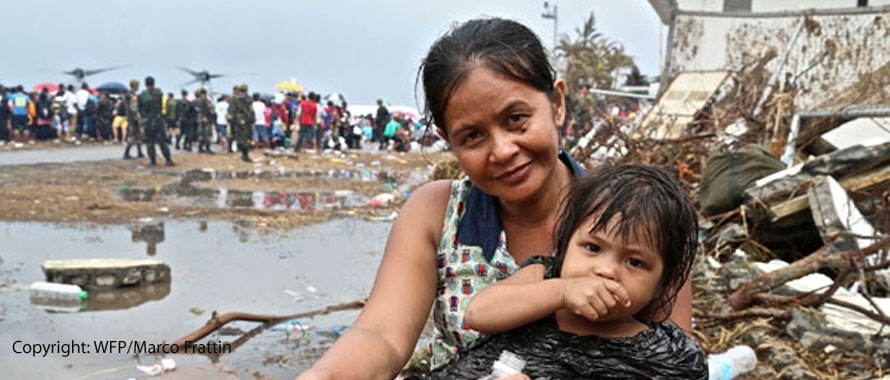November 8, 2013 was supposedly a regular days for us Filipinos especially it was Friday and we are looking forward for a fun weekend ahead. Unfortunately, few days before PAGASA (Philippine Atmospheric, Geophysical and Astronomical Services Administration) announced that there will be category 5 typhoon and one of the the strongest tropical cyclones ever recorded. The typhoon’s name was Haiyan and for us Filipinos she’s Yolanda. According to World Wide Fund for Nature (WWF) Philippines Chief Executive Officer (CEO) Lory Tan, the typhoon smashed the Central Philippines and made a landfall five times and with winds reached 330kph it was considered the strongest typhoon in the country’s history. “Despite extensive warnings and preparations, towns and cities in Leyte and Samar were flattened. She took at least 6200 lives and caused over P500 Billion in economic damage. A year on, Palawan and the Visayas still bear the scars of the storm.” Tan explained.
For the humanitarian organization like UN World Food Programme (WFP), coming from Ondoy and Sendong relief and rescue efforts that found Yolanda different. WFP-Philippines Representative & Country Director, Praveen Agrawal shared that they find challenging with Yolanda was the sheer extent of destruction and their organization reached nearly 3 million people with food assistance for those affected compare with the almost a million with Ondoy that hit Manila and approximately 300,000 in Mindanao during Sendong. WFP are very thankful to the donors from all the organizations who helped aside from the Philippines itself, help came from other countries like Australia, Austria, Azerbaijan, Canada, Denmark, Estonia, European Commission’s Humanitarian Aid and Civil Protection, Finland, Germany, Greece, Iceland, Ireland, Italy, Japan, Kuwait, Liechtenstein, Luxembourg, Netherlands, New Zealand, Norway, Republic of Korea, Russia, Spain, Sweden, Switzerland, United Kingdom, United States of America and others.
Towns and cities in Aklan, Capiz, Cebu, Iloilo, Leyte, Palawan, and Samar last year were placed under state of calamity, aside from the immediate help they need that WFP and other humanitarian organizations gave, shelter is also one of the major concerns of the affected families. Schools, churches, buildings and tents became their temporary shelter from the cold night and the trauma that they faced from the typhoon. Habitat for Humanity is one of the organizations who stood up to reach out the affected communities. Few months from the earthquake in the Province of Bohol the ReBuild Team Disaster Response and extra help coming of its Asia-Pacific office and international community, Habitat for Humanity was able to help families affected by Super Typhoon Haiyan. Charlie Ayco, CEO and Managing Director of Habitat for Humanity shared that with the help from Habitat for Humanity Great Britain, UKAid and United Kingdom’s Department for International Development (DFID), started distributing Emergency Shelter Kits (ESKs) in the affected areas of the Visayas, including the areas of Guian, Samar, Leyte and Bantayan Island in northern Cebu. To date, Habitat has already distributed 5,000 units of ESKs. Last December 1, 2013 that launched the ReBuild campaign with Red Cross and Coca-Cola and up to date they had distributed over 24,441 of the targeted 30,000 shelter repair kits throughout 14 Yolanda-affected areas and the main target is to build 30, 000 homes for the families.
As we move forward with the rebuilding still ongoing, Tan shared that no one knows when will be the next big typhoon will hit just like what happen before with Ondoy and Pepeng just like with Yolanda which he said that all cities should prepare ahead. This was the message that WWF is communicating with everyone the idea of climate change mitigation that focus on reduction of carbon, while climate change adaptation considers the management of risk. He said that the government should consider climate-proofing vital lifelines like roads, airports, seaports and communication hubs will be both the private and public sector’s unique sales proposition. With this effort it reduces downtime and maximizes the ability to bounce back from disasters, ensuring stable profit. WWF is now spearheading global climate change mitigation campaign called Seize Your Powerr that encourage on the increase of investments in renewable energy and divest from fossil fuels.
As for humanitarian organization like WFP and Habitat for Humanity, Agrawal said that disaster preparedness and response initiative should be implemented by educating everyone especially the national government partners, NGOs, local academic institutions and local government units in preparing for future emergencies, drawing from the lessons learned from the Haiyan response operation. And Ayco said that they will continue in raising fund to help the families in affected areas to finally to have their shelters.
***
I believe with what Sir Lory said we cannot predict when will the next big storm will hit us that’s why its proper to be prepared which Sir Praveen mentioned disaster preparedness is very important. And lastly with Sir Charlie we should find time to reach out to those who are in need. Yolanda is already part of our history as a nation. We remember the unnamed lives that were lost and also the heroes who reach out to those who are in need. And together we continue to rebuild and stand up from that what happened yesterday that made our country stronger.


